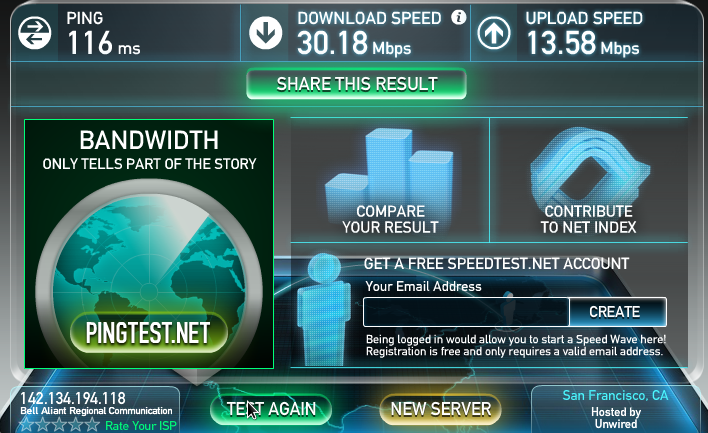Here is an update post-FibreOp install. The installation started about 9:00-9:30-ish and ended just before 4:30. There is a fair bit of work required. The fibre has to be run from the utility pole to the house. Then the UPS (battery to be added later, right now Bell-Aliant will apparently use copper for telephone until mid-summer when voice will also be added to FibreOp and the battery will be needed to support voice during a power outage), the ONT and the ActionTec router. The ONT is the “Optical Network Terminal” that simplistically converts the fibre (light) to copper (electrical).
A word on the ActionTec router: It seems like a pretty good device. It does have “true” NAT ability – e.g. single source IP or “all”, TCP or UDP port or port range and the destination (internal) IP – which is something that I have not seen on any home-grade routers. It, ironically, does not have the ability to statically assign DHCP IPs to specific MACs. Well, you can’t have everything (and a CentOS-based virtual machine running DHCP fixed that up).
Bell-Aliant prefers to use UTP in their installation. They will use good (e.g. digital cable-grade) coax but will want to replace the router-to-PVC run with UTP. They also re-terminate any coax runs. I don’t blame them – nothing worse than having to come back post-install to re-terminate a run that someone else did. The television service is quite good. I noticed that the “jagginess” that I was seeing on another coax-based provider even on the high definition channels and the overall quality seems better. I do miss a couple the old coax-provider set top box features – or maybe I have to re-discover them 😉
Oh, yes: a post of the new SpeedTest results is needed. I have used the same provided in San Francisco (nice to see what a “real” end-to-end test will look like) but there is a difference in time-of-day and day-of-week – ADSL was a Thursday around 7:30 AM-ish while FibreOp was run on a Sunday around 10:30 AM-ish – but that shouldn’t matter too much other than absolute throughput.

